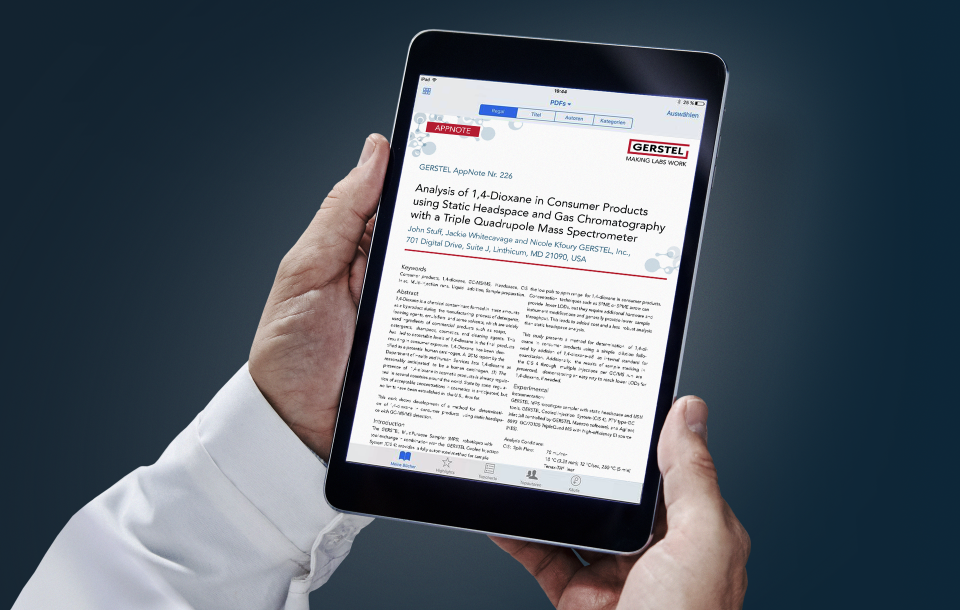To enhance the fragrance and taste of cigarettes smoke, flavor additives are often incorporated into cut tobacco. Analyzing the aroma components of cut tobacco holds significant importance. Therefore, it is crucial to select an efficient method for extracting the aroma and odor components from cut tobacco. In this study, a GERSTEL LabWorks Platform using Thermal Desorption TDU/Stir Bar Sorptive Extraction (SBSE) combined with gas chromatography-mass spectrometry is employed for the analysis and identification of volatile flavor and aroma components in cut tobacco.
Thoroughly determining the VOCs and semi-VOCs in various consumer goods using the proper extraction technique for GCMS is vital for ensuring quality control, batch consistency, regulatory compliance, and successful product development studies. However, conventional sample extraction methods face significant limitations such as the introduction of additional solvents, the inability to handle matrix complexity, and difficulty achieving extremely low detection limits.
Aroma analysis is of paramount importance in the plant-based meat industry. The ability to replicate flavors and mimic real meat is vital in appealing to consumers. To capture the aroma profiles of cooked meat, analysts may often resort to equilibrium-based headspace extraction approaches such as headspace-solid phase microextraction (HS-SPME) instead of dynamic purge approaches like dynamic headspace (DHS) sampling, despite the potential of the latter for higher recovery and sensitivity.
Material emissions in automobiles are an important subject for the whole automotive sector. The VDA 278 method is widely used for analysis of emissions from interior materials. The original GERSTEL TDS was built specifically for this method. Currently the GERSTEL TDS 3 is also widely used and for many users the question arises if the GERSTEL TD 3.5+ is equally suitable. This AppNote addresses the transfer of method VDA 278 from TDS to TD 3.5+.
Breath sampling is a technique used to aid in disease diagnosis and monitoring. Specific compounds found in exhaled breath are attributed to abnormal functional pathways due to various diseases. For instance, acetone and isoprene are indicators of poor glucose metabolism in diabetic patients. This application note investigates the use of GERSTEL TD 3.5+ Tenax TA® thermal desorption tubes for the non-invasive collection of volatile organic compounds (VOCs) from breath to determine biomarkers for glucose metabolism. Distinct changes were seen in acetone and isoprene levels corresponding to blood glucose spikes after a participant ate meals throughout the day.
Edible oils and food products containing edible oils are prone to off-odors due to lipid oxidation. However, most studies focus on the increase of aldehydes and other compounds in oxidized samples without relating the results to the sensory attributes of the sample. In this study, a sensory directed analysis (SDA) method was employed to identify key sensory-active compounds responsible for these off-odors. Off-odors were explored in cooking oil and crackers. In each case, an aged sample was compared to a fresh, positive control sample.
Non-alcoholic (NA) beers have recently increased in the market as consumers look towards healthier drink options. To gain consumer acceptance, brewers must create a product that matches the flavor of the alcoholic version and is absent of off-odors. Volatile organic compounds (VOCs) are significant contributors to beer’s overall flavor, and the ability to determine differences in these profiles can help brewers enhance the quality of NA beers. This study compared the VOCs of NA beers to their respective alcoholic beers.
Honeybees are experiencing high mortality in the United States and worldwide. Neonicotinoids, a class of commonly used insecticides, have been found in honey samples suggesting that bees and other pollinators are being exposed to these neurotoxic chemicals. Pesticide exposure has been identified as one of the stressors causing increased mortality and as a possible cause of colony collapse disorder in bees.
In the work presented here, perfluorinated compounds were extracted from different food types (egg, fish and meat) using a QuEChERS-like approach followed by online-SPE cleanup and LC-MS/MS determination. In addition to validating the analysis method in accordance with the EU Guidance Document [1], matrix-based calibrations were compared to solvent-based calibrations to illustrate the matrix effects and demonstrate the cleanup efficiency. Online-SPE enables the injection of large amounts of sample extract, helping to reach the required quantification limits of 0.01 to 0.05 μg/kg.
Pesticides are frequently determined in various food and beverage types and in environmental samples. A common sample preparation method used is known as QuEChERS (Quick, Easy, Cheap, Effective, Rugged, Safe). The method involves salting-out liquid-liquid extraction with acetonitrile and subsequent clean-up of the extract using dispersive solid-phase extraction. Usually, 1 – 2 μL of the extract is then injected into the analytical instrument for analysis. To further improve the sensitivity, automated evaporative concentration of the extract using the GERSTEL mVAP can be combined with Large Volume Injection in the GERSTEL CIS 4 inlet and GC-MS analysis.
Pagination
- Previous page
- Page 4
- Next page
